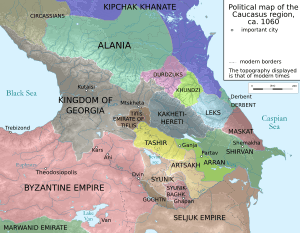Maghas
Maghas or Maas — more properly, Mags or Maks — was the capital city of Alania,[1] a medieval kingdom in the Greater Caucasus. It is known from Islamic and Chinese sources, but its location is uncertain, with some authors favouring North Ossetia and others pointing to Arkhyz in modern-day Karachay–Cherkessia, where three 10th-century churches still stand.


However, the historian John Latham Sprinkle from the University of Ghent (Belgium) claims to have discovered that Il’ichevsk is the exact location of Maghas, by consulting several written sources. "The most important were the report of an Arab geographer from the 940s on Magas and two writings from Persia and one from China from the 13th and 14th centuries on the capture of the city by the Mongols".[2] Latham Sprinkle compared these written sources to the archaeological findings collected by a local teacher in Soviet times on Il'ichevsk, where he also uncovered evidence of a burnt down church as well as the grave of a child. Il’ichevsk has never really been thoroughly researched, this may be because it is positioned in Krasnodar Krai. This is a border province that belongs to Russia itself and with leaders who turn their gaze to Moscow. "Five autonomous regions within Russia claim that they, and they alone, are the heirs of the Alans", "They are all sub-publics with a predominantly non-Russian population and a strong nationalist reflex such as Chechnya, Ingushetia and North Ossetia".[3] "Over the past 200 years, these peoples have designated several sites on their own territory as the original site of Magas to draw on the legacy of Alanië. In 1994, Ingushetia even built a brand-new capital which it also called Magas, although it has nothing to do with the historic Maghas".[4] No site designated by the autonomous regions could ever really convince archaeologists and specialists. "Magas was in the woods and was firmly defended. This did not prevent the Mongols from taking the city and destroying it in the winter of 1239-1240. So to identify Magas with certainty, we need evidence of royal control, ramparts, forests, and destruction in the 13th century. The sites that have emerged so far lack one of these four factors".[5] The irony is that Il'ichevsk is not located in any of the five autonomous regions claiming the inheritance of Alania. Latham Sprinkle's research will be published in the month of June 2020 in the scientific journal Bulletin of the School of Oriental and African Studies. Some archaeologists and specialists on site are already predominantly positive. How politicians and nationalists will react, can' be estimated. But, it may well be that many people in those areas will be particularly interested. This is their historic capital that has finally been discovered.
The destruction of Maghas is ascribed to Batu Khan, a Mongol leader and a grandson of Genghis Khan, in the beginning of 1239. Some Russian geographers, like D. V. Zayats, point to a location in Ingushetia.
The capital of the Russian Republic of Ingushetia, Magas, is named after Maghas.[6]
References
- The Jews of Khazaria by Kevin Alan Brook
- Verstraete, Alexander. "Location metropolis Magas from the Middle Ages after 200 years of searching deciphered: "Everyone was looking in the wrong place"". vrt.be/vrtnws. Retrieved 7 May 2020.
- Verstraete, Alexander. "Location metropolis Magas from the Middle Ages after 200 years of searching deciphered: "Everyone was looking in the wrong place"". vrt.be/vrtnws. Retrieved 7 May 2020.
- Verstraete, Alexander. "Location metropolis Magas from the Middle Ages after 200 years of searching deciphered: "Everyone was looking in the wrong place"". vrt.be/vrtnws. Retrieved 7 May 2020.
- Verstraete, Alexander. "Location metropolis Magas from the Middle Ages after 200 years of searching deciphered: "Everyone was looking in the wrong place"". vrt.be/vrtnws. Retrieved 7 May 2020.
- D.V.Zayats (2001). "Maghas – "The Sun City" – New Capital of Ingushetia". Archived from the original on 2 May 2013. Cite journal requires
|journal=(help)